 |
| Film Ferrania P30 Alpha |
Earlier this year, Film Ferrania made a
surprise announcement: their first commercially available product was to be a black and white negative film,
Ferrania P30 Alpha, based on a discontinued motion picture emulsion. The announcement generated a great deal of excitement among film photographers online, more perhaps than other new film stocks that have appeared in recent years, such as
Adox Silvermax or
Foma Retropan 320 (there have been quite a number of 'new' films, but many of which are essentially the same: namely the 100 and 400 speed Kentmere/Rollei RPX/Agfaphoto APX/Fotoimpex CHM films). This excitement no doubt reflects the enormity of Film Ferrania's project of restarting production of colour transparency film at the original Ferrania factory in Italy, and the support and goodwill that initially accompanied the Kickstarter project of three years ago, and following its success, the numerous problems and delays that followed. The P30 film was initially made to test coating machinery that would be used to manufacture the colour transparency film that was Film Ferrania's original intention; given the delays to this, that a usable film could now be produced, after all the difficulties encountered in getting production running once more, no doubt it has made commercial sense to release this onto the market, albeit in limited amounts, in 35mm only, against what seems to have been a huge demand. I didn't support Ferrania's
original Kickstarter campaign, in part due to rarely shooting colour film, but when the first product from Ferrania was announced to be a black and white negative film, I was keen to try it. My order was the from the second production batch, arriving from Germany, not Italy, from Mahn, suggesting that Mahn is handling Ferrania's logistics at this stage.
The cartons have no information inside; the plastic tubs have a sticker with the year and production batch. The film canisters are not DX-coded, with labels stuck on to them, rather than designs directly printed onto the metal. Peeling the labels off out of curiosity, the canister underneath was that of a C41 film, Centuria HD 200. Another observation about the packaging is that the film is described as 80 ASA, not ISO, although this makes no practical difference.
As with using other films for the first time, my approach was to test the film for its latitude. For most of the tests in this post, I divided the film in half, which I did for the first test, shot with a
Canon FTb-N. The first two rows of the contact sheet below were successively rated at exposure indexes of 20, 40, 80, 160, 320, 640, reading left to right. The test was shot early on a day with bright sunlight; from examples I'd already seen online, I knew it was going to be contrasty.
 |
| Ferrania P30 Alpha latitude test contact sheet |
On the
online 'Best Practices' sheet, the only listed developer I use regularly is Rodinal. At the time that I developed my first roll, the developing time given with a dilution of 1+50 was 8 minutes (all rolls of Ferrania P30 Alpha in this post were developed by hand in a small tank with intermittent agitation). The results when I pulled the first roll out of the wash did indeed show negatives of high contrast with very little shadow detail; the results appeared to demonstrate there was little latitude to the film: when overexposed by two stops, the tonal separation between the highlights and midtones made scanning difficult, while the underexposed frames were extremely thin and not worth scanning.
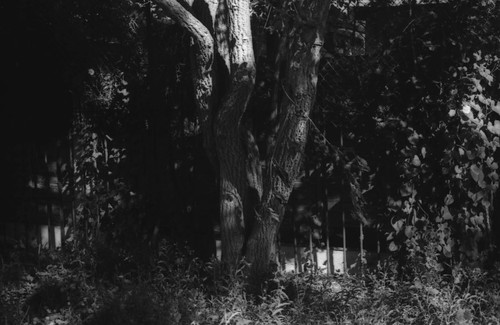 |
| Ferrania P30 Alpha shot at 80, developed in R09 One Shot, 1+50, 8m at 20º |
In the image above, there is very little shadow detail; the lower contrast subject below was better, but the first roll of film was initially unsatisfactory.
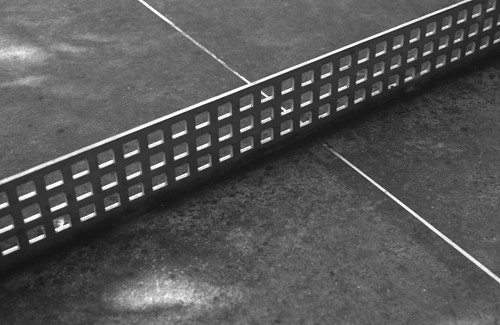 |
| Ferrania P30 Alpha shot at 80, developed in R09 One Shot, 1+50, 8m at 20º |
I decided to make a second latitude test, using the same ratings (and camera), this time choosing stand development with Ilfotec LC29, diluted 1+100 for one hour. Ilfotec LC29 was not listed on the 'Best Practices', sheet but it's a developer I use regularly, and seems to give equally good results for stand development as compared to RO9 (the developer does appear to exhaust more rapidly at higher dilutions however).
 |
| Ferrania P30 Alpha stand development latitude test contact sheet |
From this test, the results when rated at 20 and 40 were clearly better than at 80, but the higher-contrast subjects again had no shadow detail at all, appearing to show a very sharp falling off. I had hoped that stand development in highly dilute developer might reduce the contrast of the negatives, but the results from this second test were less successful than the first roll. After the results from the first two tests, I was however able to appreciate that the film's grain is extremely fine (in some dense areas of the negatives, there is scanner noise visible rather than grain itself). In addition, the base has a light grey tint, but is very clear, and the clearness of the film base did show up dust (and a few scratches and my own carelessness in washing) very well in scanning, with the result that I spent a fair bit of time in digital spotting. In comparison to other emulsions, P30 Alpha was quite reminiscent of
Rollei RPX 25, which has a number of comparable considerations in exposure and development.
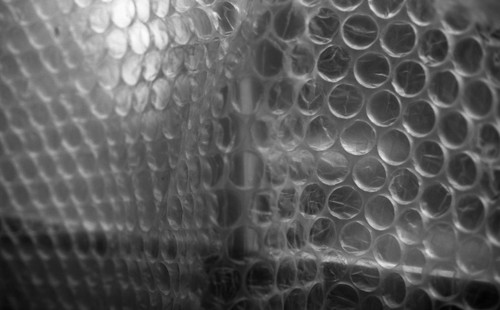 |
| Ferrania P30 Alpha, rated 20, stand developed in Ilfotec LC29 |
I did wonder whether there might have been problems with metering, having shot both tests with the same camera, and both showing a complete lack of detail in the shadow areas in negatives where the subject contained a wide range of tones. Closer-toned subjects did have better results, but were notably thin when rated at box speed, being better at an exposure index of 40 or 20.
After shooting a third roll in a different camera (a
Canon A-1, which I generally trust on metering - and this camera had also just received a new battery), and rating the film at 50, before developing, I checked the recommended time for R09 online, and found that the time given for a dilution of 1+50 had increased to 14 minutes. Evidently one issue with using a new emulsion is the lack of information about developing regimes, and with the release of Ferrania P30 in its Alpha phase, the manufacturers are relying on the film being tested by its purchasers. I first downloaded the 'Best Practices' sheet (as version 1.1) on the 12th of last month; the recommended time with R09 had changed two weeks later, the 'Best Practices' sheet at that point being version 1.3 (the version at the time of writing is now 1.4). The metering recommendation for the new time was still 80 ISO; however, with my experiences so far, I rated the film at 50 instead.
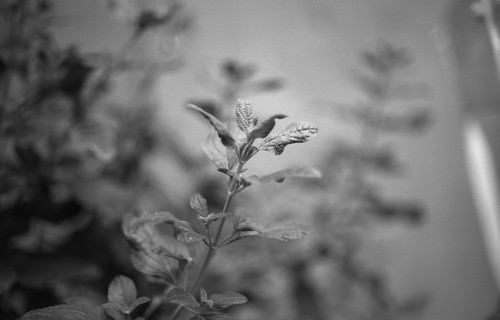 |
| Ferrania P30 Alpha, rated 50, developed in R09 1+50, 14m at 20ºC |
The negatives when developed at 14 minutes revealed a fuller range of tones, the image above being one of the best at the new time; however, with this roll, I shot a number images with a large amount of sky. I used a yellow filter to attempt to retain detail in the sky, but the balance between the highlights and shadow areas, made the negatives difficult to scan.
 |
| Ferrania P30 Alpha, rated 50, developed in R09 1+50, 14m at 20ºC |
In addition to the new time for R09 One Shot, there was also a new developer listed, Ilfotec DD-X. As I happened to have some DD-X, it seemed worth trying this as well. Ilford's standard dilution for DD-X is 1+4; the 'Best Practices' sheet gives a dilution of 1+5 (perhaps to give slightly lower contrast), and to rate the film at 50. I shot some P30 Alpha with the
Agat 18K, and developed as on the 'best practices' sheet. This roll was shot mostly in overcast conditions, with the lower contrast in the lighting giving a good, rounded tonal range. Incidentally, the film's fine grain was a good match for the smaller negative format of the 35mm half-frame, while shooting at an exposure index of 50 meant using wide apertures with the Agat 18K, sympathetic to the subject below.
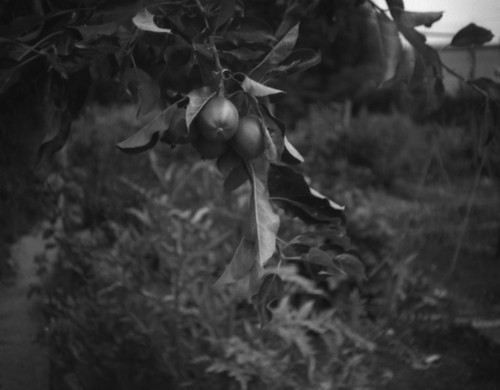 |
| Ferrania P30 Alpha, Agat 18K (half frame), developed in Ilfotec DD-X |
Returning to using R09, feeling that the contrast in the negatives could be reduced further, I decided to try a higher dilution - but not with stand development. As with the best results that I had with Rollei RPX 25, I chose a dilution of 1+120. Logically, the time needed to be extended from the 14 minutes at 1+50 in the previous R09 test; in addition, following the old adage to 'expose for the shadows and develop for highlights', I rated the film at 40: the high developer dilution should take care of the highlights, and shooting at a lower exposure index should ensure better shadow detail. The negatives from this roll appeared to demonstrate that this approach was an appropriate one.
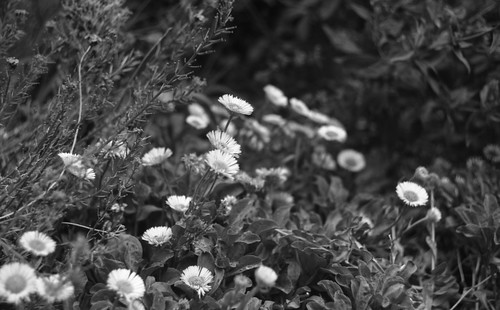 |
| Ferrania P30 Alpha, rated 40, developed in R09 1+120 for 18m at 20ºC |
I did bracket some shots, rating a few alternate frames at 80 for comparison. As the pair of images below show, the results at 40 provide much more shadow detail, while the higher dilution of developer appears to have prevented the highlights from blocking too much, making the negatives much easier to scan. The conditions that many of the photographs were shot in continued to be
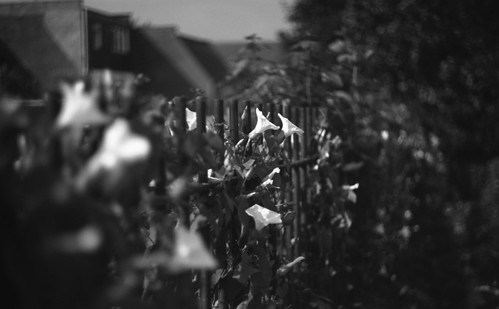 |
| Ferrania P30 Alpha, rated 40, developed in R09 1+120 for 18m at 20ºC |
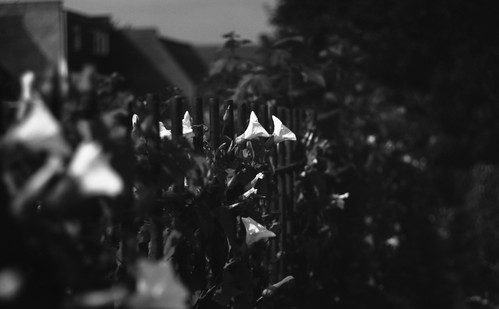 |
| Ferrania P30 Alpha, rated 80, developed in R09 1+120 for 18m at 20ºC |
For this test with a higher dilution, I shot the film with a
Kiev-4. At the end of the film, in attempting to advance one more frame, the film tore (something I have occasionally done with the Kiev-4). The 'Best Practices sheet' does state: "No Motorized Cameras Please: We have seen some motorized cameras break the film, especially less-expensive point-and-shoot cameras from the 80s and 90s. We really think it’s best to use a fully manual, non-motorized camera".
Having found what seemed to be a good exposure and developer combination with R09, I also was concerned to find an exposure index and developing times for Ilfotec LC29. This is the other main film developer I use, in conjunction with R09 One Shot, and as well as using it for stand development, it seemed that it might be worth finding a time for standard development with agitation.
I shot some film with a
Kodak Retina IIa, choosing to rate the film at 80 once more. For the choice of dilution with Ilfotec LC29, I used 1+29, which is considered a 'one shot' dilution (rather than the developers other dilutions of 1+9 or 1+19). For a developing time, I picked a rather speculative estimate, based in part on making comparisons to DD-X, taking 9 minutes, at a slightly lower temperature of 19ºC. These negatives were dense, but did appear to have a good tonal range.
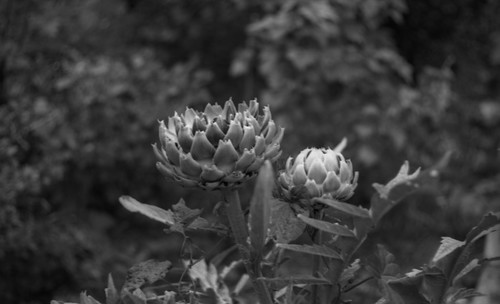 |
| Ferrania P30 Alpha, rated 80, developed in Ilfotec LC29 1+29 for 9m at 20ºC |
I made a further test, reducing the developing time to 7 minutes, at 20ºC, keeping the same exposure index of 80.
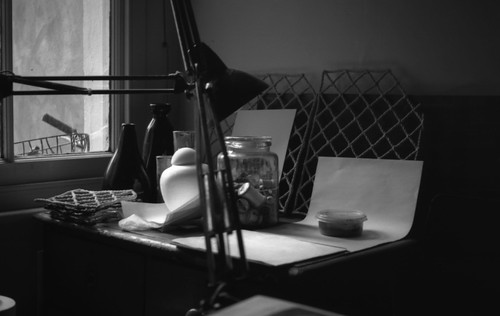 |
| Ferrania P30 Alpha, rated 80, developed in Ilfotec LC29 1+29 for 7m at 20ºC |
The results with Ilfotec LC29 might have been better with a little more exposure, but as I had just one roll of film left, I wanted some confirmation of what I considered the best results so far, developing the film with R09 One Shot at 1+120. Given that the negatives appeared a little thin, I decided to extended the development time by a couple of minutes. As I had done perviously, I divided the roll of film, shooting half in the Canon A-1, rated 50, and the other half in the Kiev-4, rating this at 40. Both films were developed together in R09 One Shot at 1+120 for 20 minutes at 20ºC. The first shot below is with the Kiev-4, the second with the Canon A-1.
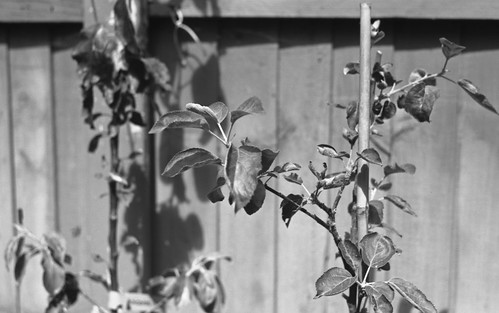 |
| Ferrania P30 Alpha, rated 40, developed in R09 One Shot 1+120 for 20m at 20ºC |
 |
| Ferrania P30 Alpha, rated 50, developed in R09 One Shot 1+120 for 20m at 20ºC |
Again, I had a number of shots in which the sky predominated, with the continuing bright and fine weather giving high contrast lighting conditions. These were difficult to scan and keep detail in both highlights and shadows. Taking advantage of the Canon A-1's capability to double-expose, I also tried to use the technique of 'pre-exposure' on some frames. Essentially, this means exposing the film to a minimum threshold of density, which should provide higher values in the shadow areas in the subsequent exposure while leaving the highlight area unaffected. In practice I used a white door, shooting the pre-exposed frame around three stops below the meter's recommendation (a grey card may have been better). The results are not clearly different; the pre-exposure levels might have been higher, although the danger is that this might appear as a grey veil, the same as fog.
 |
| Ferrania P30 Alpha, rated 50, developed in R09 One Shot 1+120 for 20m at 20ºC |
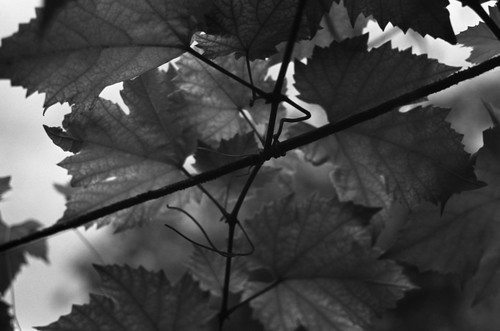 |
| Ferrania P30 Alpha, rated 50, with pre-exposure, R09 One Shot 1+120 for 20m at 20ºC |
Having used Film Ferrania P30 Alpha quite extensively through all the tests that I made, I did begin to get a feel for how the film behaves and how I would tailor exposure and development to suit my personal preferences. The 'Best Practice' sheet does state that "The cinema heritage of P30® ALPHA means that the film is rather precise in the way it “wants” to be shot and processed. As such, we firmly recommend shooting this film at the box speed of 80 ISO." - in all the tests I made, I found that this was rarely the case. As a qualification of this conclusion, this does of course very much depend on the 'look' one wants to achieve with a particular emulsion, and how successfully this can be done with its inherent characteristics. I generally prefer to start with as long a tonal range as possible in my negatives (within reason), which can then be affected in scanning or printing (all the images on this post with the exception of the contact sheets were scanned from the negatives) - high contrast in a negative itself can be limiting in this regard. With none of the developers I currently use would I rate the film at 80 - with the exception perhaps when using Ilfotec LC29, although I don't feel that I quite got the combination of exposure and development right there. To my mind, P30 Alpha does suit certain subjects over others: the difficulty in retaining detail in bright skies while maintaining good tonal separation in landscape shots was occasionally frustrating; still-life subjects, dramatic, abstract geometrical compositions really benefit, as does any subject with fine texture where the tight grain of the film is beneficial. Hopefully, Film Ferrania will gone on to achieve their original ambition of making colour transparency film in all formats promised; and hopefully there will be a P30 Beta, and then perhaps, in a wider variety of formats other than just 35mm, a large scale production version of the film.
 |
| Ferrania P30 Alpha rated 80, developed in R09 One Shot, 1+50, 8m at 20ºC |
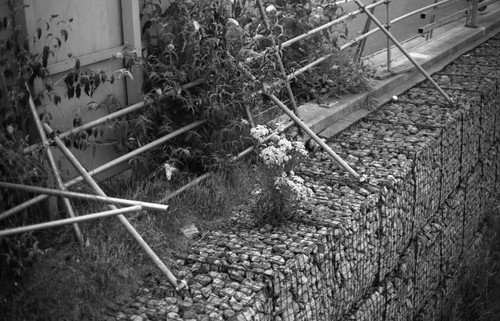 |
| Ferrania P30 Alpha rated 50, developed in R09 One Shot, 1+50, 14m at 20ºC |
 |
| Ferrania P30 Alpha, rated 50, developed in Ilfotec DD-X 1+5, 7m30s at 20ºC |
 |
| Ferrania P30 Alpha, rated 80, developed in Ilfotec LC29 1+29 for 9m at 19ºC |
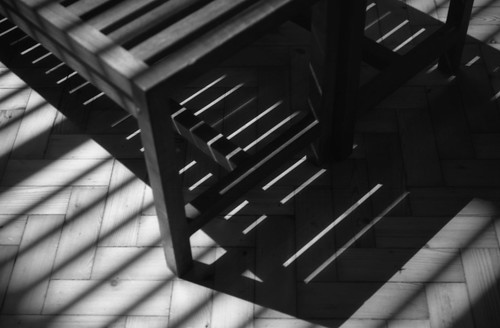 |
| Ferrania P30 Alpha, rated 80, developed in Ilfotec LC29 1+29 for 7m at 20ºC |
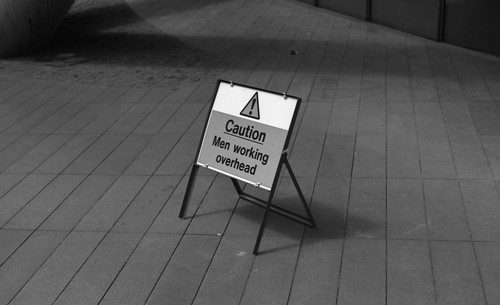 |
| Ferrania P30 Alpha, rated 40, developed in R09 One Shot 1+120 for 18m at 20ºC |
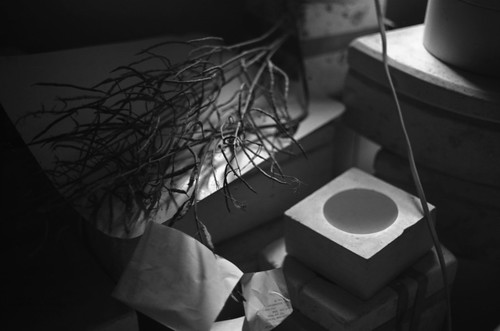 |
| Ferrania P30 Alpha, rated 50, with pre-exposure, R09 One Shot 1+120 for 20m at 20ºC |
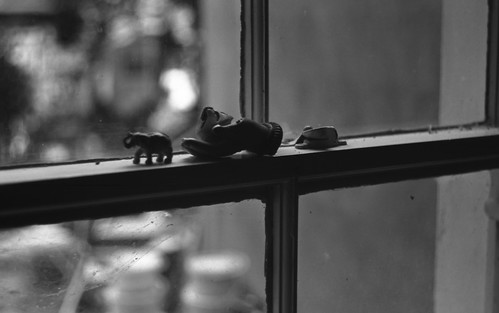 |
| Ferrania P30 Alpha, rated 40, developed in R09 One Shot 1+120 for 20m at 20ºC |




























Seems to be a rather diffcult film. I wonder how it would perform in Caffenol?
ReplyDeleteI've never used Caffenol, but from what I understand it's a compensating developer and so has some characteristics similar to Rodinal.
DeleteI was wondering the same https://flic.kr/p/WV4vVM
ReplyDeleteThanks for sharing your results - I've definitely found P30 is best rated at 40/50 - your photographs in Caffenol seem to bear this out.
DeleteThanks for sharing, there's not much info yet about developing P30 in LC29.
ReplyDeleteBased on this post I exposed a roll of P30 at 40iso, and developed it in LC29 1+29 for 6m45 at 20C. The negatives look good to me, 40-50 iso seems to be the right ballpark.
It does seem that using a yellow filter requires a more conscious exposure correction. There where I usually let the camera's TTL meter deal with it (shows a 1/2 stop difference with the filter on, and the film latitude takes care of the rest), P30 really requires a >1 stop correction.
Thanks for your comments - and sharing your experiences. I think I also noticed that using a yellow filter needed more correction - some of the shots with the Retina and the Canon A-1 I used yellow filters, and I didn't correct beyond the TTL metering with the Canon, which appeared to have the effect you observed.
Delete